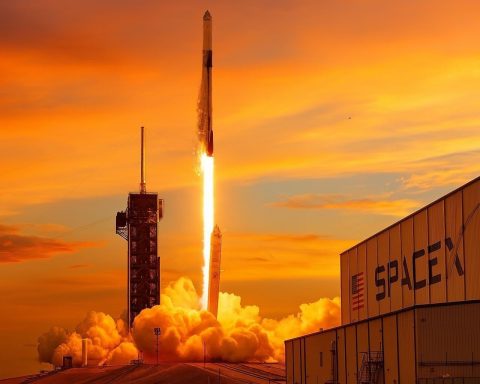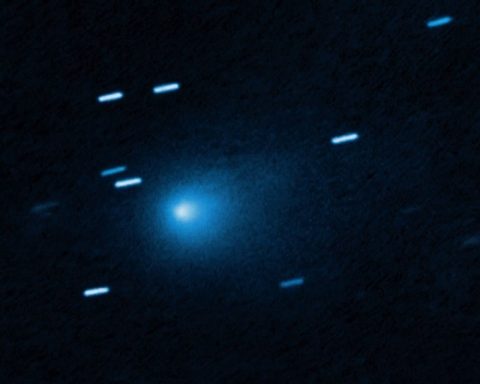Key Facts
- Major Agency Moves: NASA gears up for the Artemis II mission – the Orion spacecraft is being integrated with the SLS rocket, targeting launch by April 2026 [1]. ESA unveiled “Pulse”, a new framework to streamline satellite operations, and signed a contract with Avio to develop a fully reusable upper-stage rocket [2] [3]. China’s space program achieved two big wins: a Fengyun 3H weather satellite launch and the 100th flight of its Long March 2D rocket [4] [5].
- Commercial Space: SpaceX announced that Starship Flight 11 (its giant Mars rocket) is set for liftoff on Oct. 13 from Texas, marking the final launch of its current “Version 2” model [6]. Private company Axiom Space revealed Project Astronaut, training a Portuguese physiologist for future private station missions [7] [8]. Rocket Lab inked a record deal: 10 more Electron launches for Japan’s Synspective SAR satellite constellation (21 launches total) [9] [10].
- Satellites & Launches: Europe’s Sentinel-6B ocean-monitoring satellite entered its final processing phase, aiming for a SpaceX Falcon 9 launch this autumn [11]. China’s new Fengyun 3H meteo-satellite successfully launched on Sept. 30 to bolster weather forecasting [12]. China’s Long March 2D rocket flew its 100th mission (an unbroken success streak) on Sept. 30, deploying two Shiyan technology satellites [13].
- Crewed Exploration: NASA held a media briefing (Oct. 1) for astronaut Chris Williams’ upcoming Soyuz flight to the ISS. (Williams will launch Nov. 27 to join Expeditions 73/74.) The ISS program also marked 25 years of continuous human presence this fall [14].
- Expert Commentary: ESA engineer Katarzyna Cichecka hailed Pulse as “a foundational step towards an integrated, agile operational culture within ESA” [15]. Axiom’s Project Astronaut chief Emiliano Ventura says the program “inspires… the global community” and advances space research [16]. Rocket Lab’s CEO Sir Peter Beck emphasized that “reliable launch on a flexible schedule” is critical for constellations, calling the Synspective deal an “honor” [17].
- Market Trends: The space economy keeps booming: a Space Foundation report (July) noted a record $613 billion global space market in 2024, driven 78% by commercial space (launches, satellites, services) [18]. Analysts project it could top $1 trillion by 2032 as broadband and Earth-observation constellations expand (Space Foundation CEO Heather Pringle) [19].
- Up Next: The race continues – from NASA’s Artemis moon program to new mega-rocket flights and swarms of LEO satellites. Watch for Starship Flight 11 (Oct 13) and Europe’s Ariane 6 slated for debut soon. The space industry is poised for even faster growth as agencies and companies pursue reusable rockets and vast new constellations.
Global Space Agencies: Moon Rockets and Modern Operations
NASA (USA) focused on its Artemis lunar program. On Sept. 30, NASA announced that the Orion Stage Adapter (which connects the SLS rocket’s upper stage to Orion) was installed for Artemis II [20]. This brings the integrated SLS–Orion stack closer to its no-later-than April 2026 launch. NASA explains that “in the coming weeks” engineers will mate the Orion crew capsule to the rocket [21]. This Artemis II mission will be the first crewed flight of SLS/Orion, carrying astronauts around the Moon. Meanwhile, NASA is also finalizing Europe’s Sentinel-6B satellite (co‑funded with ESA/NOAA) at its processing facility. Sentinel-6B “will extend the gold‑standard sea level record into its fourth decade” and is targeting launch on a SpaceX Falcon 9 this fall [22].
At the International Astronautical Congress (IAC) in Sydney (Sept 29–Oct 3), NASA’s top brass joined global counterparts in emphasizing partnerships. (Acting NASA Admin Sean Duffy even held a livestream interview on Sept. 28.) NASA also announced an Oct. 1 news conference for astronaut Chris Williams’ Soyuz mission to the ISS (launch Nov. 27). Williams will spend eight months aboard the ISS, marking the continued US–Russia cooperation on station missions [23]. Notably, NASA’s ISS program celebrated 25 years of continuous crewed operations this fall [24], underscoring the lab’s role in preparing for future Moon and Mars missions.
ESA (Europe) rolled out two big initiatives. First, ESA unveiled Pulse, a new cross-mission control framework. As missions multiply, Pulse “links operational data, enhances responsiveness, and reduces fragmentation” across centers [25] [26]. Katarzyna Cichecka, head of systems engineering at ESA, hailed Pulse as “a foundational step towards an integrated, agile operational culture within ESA” [27]. Early tests on the Swarm Earth-magnetic field constellation next year will prove out the approach. Second, at IAC on Sept. 29 ESA signed a €40 million contract with Avio (Italy) to develop a reusable upper-stage rocket demonstrator [28]. ESA’s Space Transportation chief Toni Tolker-Nielsen called the deal “two-fold: it addresses technological criticalities in the short term, and…paves the way for Europe’s long‑term future in space” [29]. This effort explores bringing the last stage of a launcher back for reuse, mirroring trends toward fully reusable rockets worldwide.
CNSA (China) announced ambitious progress. On Sept. 30, state media (Xinhua via SpaceDaily) reported China successfully launched Fengyun-3H, a next-gen meteorological satellite, aboard a Long March 4C rocket [30]. Fengyun-3H, carrying advanced infrared and microwave sensors, will greatly enhance China’s climate and weather forecasts [31]. That launch was China’s 58th space mission of 2025 [32]. Separately, on Oct. 1 CNSA released news that its deep‑space probe Tianwen 2 (MarsSample return mission) has reached the halfway point on its journey to asteroid 2016 HO3 [33]. After four months in flight, Tianwen-2 has traveled ~43 million km on its way to grab asteroid samples in 2026. Analysts note the mission’s significance: it’s China’s first asteroid sample-return attempt.
Also, on Sept. 30 China marked a launch milestone: the Long March 2D rocket flew its 100th consecutive mission without failure [34]. Carrying two Shiyan experimental satellites, the LM-2D (a proven medium‑lift launcher) has never lost a vehicle in three decades [35]. China’s aerospace corps touted the “gold-medal rocket” achieving 100 out of 100 successful flights, a testament to its reliability and its role in China’s record 60 missions in 2025 so far [36].
Other agencies: No major press releases were noted on Sept. 30/Oct. 1 from Roscosmos (Russia), ISRO (India), or JAXA (Japan) beyond ongoing missions. (Roscosmos continues Progress cargo flights to ISS; India’s NISAR satellite is ramping up for full science operations after its first radar images [37]; JAXA monitors its Akatsuki Venus orbiter and prepares HTV-X launches). But the key news spotlight fell on NASA, ESA, and CNSA activities.
Commercial Launches and Milestones
SpaceX: Early reports on Sept. 30 flagged SpaceX’s next mega-mission. Space.com confirmed that SpaceX is targeting Oct. 13, 2025 for Starship Flight 11, the next suborbital test of its 400‑ft Super Heavy/Starship launch vehicle [38]. This mission will be the last “Version 2” Starship flight; Flight 12 and beyond will debut larger “Version 3” and “Version 4” rockets [39]. SpaceX wrote that Flight 11 will mimic Flight 10 (Aug. 26, 2025), including deploying dummy Starlink satellites and then splashing down the booster and ship in planned zones [40] [41]. SpaceX emphasized Starship’s reusability: the Super Heavy booster B15 (flying its second time) will splash down in the Gulf of Mexico, and the Ship upper stage in the Indian Ocean after a dynamic banking reentry burn.
Meanwhile, SpaceX continues its Falcon 9 workhorse schedule. (A Falcon 9 launched 28 Starlink V2 mini-satellites from Vandenberg on Sept. 28 [42].) According to Spaceflight Now’s schedule, another Starlink launch is set for Oct. 3 (launch number ~328) [43]. The commercial competition heats up: ULA’s forthcoming Atlas V will launch Amazon Kuiper satellites on Oct. 6/7 [44], and SpaceX has permits filed for thousands of Starlink satellites (SpaceX reportedly seeks FCC approval for 15,000 MSS satellites [45]).
Blue Origin: No breakthrough announcements on Sept. 30–Oct. 1. Blue Origin’s New Shepard suborbital program completed its 35th mission in mid-Sep (fly dozens of experiments) [46], and it’s gearing up for monthly flights. Blue’s New Glenn heavy rocket is in advanced factory assembly (site tours reported), with a projected first launch in 2025. (Separately, Amazon/Kuiper reported on Sept. 25 that their ViaSat-3 F2 satellite launch was rescheduled for October.)
Rocket Lab: The small-launch specialist scored a major contract on Oct. 1. SpaceDaily reported that Japan’s SAR constellation operator Synspective signed for 10 more dedicated Electron launches [47]. This brings the total StriX-4 radar satellites to 21 to be deployed by Rocket Lab through 2030 [48]. Rocket Lab founder Peter Beck said this is the company’s largest single‑customer order ever. He emphasized that “regular and reliable launch on a flexible schedule is essential” for constellations – calling it “an honor to add another 10 StriX satellites to Electron’s launch manifest and continue our long-standing partnership” with Synspective [49]. Synspective’s CEO echoed the sentiment: Rocket Lab’s precision has “enabled us to stay on schedule and achieve our mission objectives”, and “continued collaboration is crucial to accelerating the deployment” of their SAR network [50]. This deal underlines a trend: smallsats are booking rapid, repeat rides to orbit (Rocket Lab has already lofted 6 StriX satellites).
Other commercial news: Axiom Space announced Project Astronaut, a pioneering training program for future commercial astronauts [51] [52]. Portuguese physiologist Emiliano Ventura will test a six-month training regimen to prepare non-traditional spacefarers. Ventura says he is “honored” to join this program, which “advances scientific research” and “inspires… Portugal and the global community” [53]. Axiom’s Chief Astronaut Michael López-Alegría explained that veteran astronauts (including Lopez-Alegria himself, Peggy Whitson, and Koichi Wakata) will personally train alongside Ventura [54]. This effort highlights how private firms are expanding human spaceflight beyond NASA.
In contrast to the highs, not all was smooth: Firefly Aerospace reported a setback on Sept. 29 (SpaceFlightNow, Sept. 30). During a static-fire test in Texas, the Alpha rocket booster for its next mission (Flight 7) suffered a catastrophic anomaly and was destroyed [55]. The company said the stage “experienced an event that resulted in a loss of the stage” [56]. Firefly’s CEO Jason Kim had been optimistic days earlier about resuming Alpha launches “in the coming weeks” after an April in-flight failure, but this ground-test explosion means a new delay. Lockheed Martin (the customer) and investors will await a thorough failure investigation.
Satellite Programs and Launch Updates
Sentinel-6B (Europe/USA): On Sept. 30, ESA and NASA announced that the new Sentinel-6B ocean altimetry satellite has entered payload processing. Now at Astrotech (Florida), Sentinel-6B is being integrated and tested for sea-level measurement accuracy [57]. Officials noted that Sentinel-6B will continue the 30+ year record of global sea-level rise tracking, after the successful Sentinel-6 Michael Freilich mission. NASA says it’s targeting a SpaceX Falcon 9 launch for late 2025 [58].
Fengyun 3H (China): SpaceDaily (Xinhua) reported that on Sept. 30 a Long March 4C rocket launched the Fengyun-3H weather satellite into sun-synchronous orbit [59]. With nine advanced instruments (infrared and microwave sounders, imagers, etc.), Fengyun-3H will “improve China’s capabilities in global numerical weather prediction, tracking climate change, and mitigating meteorological disasters” [60]. It is part of a constellation of 22 Fengyun weather satellites since 1988. This mission boosted China’s 2025 launch tally to 58, reflecting the country’s rapid expansion of Earth-observation assets.
Synspective SAR (Rocket Lab): As noted, Rocket Lab’s Synspective deal means another wave of LEO satellites coming up. Synspective’s StriX satellites carry synthetic-aperture radars to image the Earth, with applications in urban monitoring and disaster response. Rocket Lab will loft 10 additional StriX payloads on Electron rockets over the next few years [61]. The contract highlights how commercial operators are fielding dozens of specialized satellites via small launchers.
Long March 2D 100th Launch (China): A very newsworthy event on Sept. 30 was China’s announcement that its veteran Long March 2D booster had just completed its 100th mission, without a single failure [62]. The two Shiyan 30 satellites it carried (experimenting with reconnaissance technologies) were successfully deployed from Xichang. Since 1992 the LM-2D has a “perfect record” and has lofted 316 payloads [63]. Achieving 100 flights makes it a rarity in rocketry. SpaceDaily noted this also marked China’s 598th Long March launch overall and 60th orbital launch of 2025 [64].
Starlink/Kuiper/OneWeb: On the U.S. side, SpaceX continues Starlink batch launches. (On Sept. 28 SpaceX sent 28 more Starlink V2 minis to orbit [65], raising the constellation above ~8,400 satellites.) Rival Amazon/Kuiper is also entering orbit: ULA’s Atlas V is scheduled Oct. 6–8 to deploy a fresh batch of Kuiper internet satellites [66]. In Europe, Eutelsat completed integration of the OneWeb network (following its 2023 acquisition) and now brands all under the Eutelsat name [67]. These LEO broadband constellations represent a huge growth market: researchers note the revenue potential of global internet access is fueling billions of investment in satellite launches.
Aviation & Comms: On Sept. 30 NASA’s latest avionics video and images from Earth observation missions (e.g. GOES-T satellite tests) were shown, but no major incidents were reported. One significant note: Spaceflight Now’s schedule listed a U.S. DoD/FAA action on Sept. 30, but details were scarce; likely routine satellite licensing or debris mitigation rules (as experts often raise concerns about congestion).
Crew Missions and Exploration Updates
Apart from Artemis II preparations, the human spaceflight story on these days was quiet. NASA continued training its next astronaut corps and preparing NASA-ROS cosmonauts for station flights. The Chris Williams news briefing (Oct. 1) set the stage for Soyuz MS-28, which will lift Williams plus two Roscosmos crew (Kud-Sverchkov and Mikaev) to the ISS in November [68]. This mission, framed as part of ISS Expeditions 73/74, keeps up the U.S.–Russia shuttle partnership on station despite Earth tensions. Experts emphasize that “protecting life and property” (like ISS operations) is always exempt from any U.S. government shutdown drama [69].
Meanwhile, commercial ISS missions progress. Axiom Space – which is building a commercial station module – continues its series of private crew flights. Axiom completed its 4th crewed Dragon mission in mid-2025 and has Astronaut Missions 5 and 6 in planning stages. NASA is evaluating future private missions as the ISS nears retirement (currently planned ~2030) [70]. (Veteran astronaut Peggy Whitson, now Axiom’s Chief Astronaut, remains involved in training new entrants.) No new spacewalks or robotic mission news hit the headlines on Sept. 30 / Oct. 1, but of note: NASA previewed an Oct. 2 probe launch (SWFO-L1) to study space weather, and a NASA high-altitude flight (WB-57) is surveying cosmic rays, reflecting ongoing research flights.
Planetary Exploration: There were no fresh NASA or ESA probes launched on these dates, but China’s Tianwen 2 story on Oct. 1 was notable. Hitting the halfway mark to its asteroid target is a big milestone. Science teams will be analyzing Tianwen 2’s trajectory and preparing the sample-collection phase. (After returning asteroid samples, the probe will continue to a main-belt comet, a first in deep-space mission planning.) The U.S. ISRO-funded NISAR satellite (launched July 2024) released its first radar images on Sept. 25 [71], demonstrating advanced Earth-monitoring capability. And NASA’s Parker Solar Probe and Argo ballistic launch from last month continue cruise testing.
Expert Statements and Industry Voices
This period saw many officials weighing in:
- ESA: Pulse lead Katarzyna Cichecka said at launch, “Pulse is a foundational step towards an integrated, agile operational culture within ESA” [72], underscoring how the agency hopes to unify mission control. Juan Piñeiro, lead architect, added: “From a mission operator’s point of view, Pulse changes how we see and manage monitoring and control activities…” [73].
- Axiom Space: Project Astronaut leader Emiliano Ventura remarked, “I am honored to participate in Axiom Space’s first Project Astronaut initiative… This program not only advances scientific research but also inspires the people of Portugal and the global community” [74]. Veteran astronaut Michael López-Alegría praised Ventura and the program’s impact: “Project Astronaut embodies Axiom Space’s dedication to mission readiness and continuous improvement”, noting that Whitson, Wakata, and he will personally train alongside Ventura [75].
- Rocket Lab / Synspective: CEO Sir Peter Beck explained that for constellations, “regular and reliable launch on a flexible schedule is essential…” He called it an honor to win Synspective’s order and continue their partnership [76]. Synspective CEO Dr. Motoyuki Arai similarly stressed Rocket Lab’s role: “Rocket Lab’s precision and track record have consistently enabled us to stay on schedule and achieve our mission objectives…continued collaboration is crucial to accelerating the deployment of our SAR satellites” [77].
- Space Foundation (Industry outlook): In July’s economic report, Space Foundation CEO Heather Pringle noted, “Space is not just a frontier for exploration; it is a cornerstone of our economy and security.” She highlighted that the booming commercial sector drove the global space economy to $613 billion in 2024 [78]. The report projects unprecedented growth: “Space Foundation projects the global space economy could cross the $1 trillion mark as soon as 2032” [79], given growing launch rates and constellations.
- Regulatory / Policy: SpacePolicyOnline (Sept. 28) warned of a potential US government shutdown on Oct. 1 affecting NASA. Thankfully, Congress passed a continuing resolution on Sept. 30 averting any lapse until early 2026, so NASA programs (like ISS operations) remain funded for now. On the international side, Australia’s space agency head announced new Artemis-related partnerships (the Artemis Accords, IAC highlights) – reflecting space diplomacy themes.
Market and Tech Trends
Analysts see the industry accelerating. Recent reports note that satellite broadband and Earth-observation markets are surging. For example, Synspective’s contract and New Glenn’s scheduled hurricane-monitoring mission (ESCAPADE) reflect the data-driven space economy. A September SpaceNews analysis also highlighted new commercial efforts in space domain awareness and orbital services (e.g. contracts like Northrop’s hypersonic navigation work).
One clear trend is reusability: both SpaceX and now ESA/Avio are pushing fully reusable rockets (as seen in the new ESA-Avio contract). Another trend is the private space station race: with NASA supporting Axiom and Sierra Space’s Dream Chaser (though Dream Chaser was delayed, highlighting development risks).
Financial forecasts are optimistic but cautious. The Space Foundation’s mid-year report (July) shows demand catching up: 149 orbital launches in H1 2025 (a launch every 28 hours!) and commercial investment up 7.8% [80]. Yet some experts warn of bottlenecks (like FCC licensing for thousands of LEO satellites, or ground station congestion) and geo-political risks (competition in military space). Deloitte’s recent forecast (Jan 2025) projected the industry could be worth up to $800 billion by 2027 if growth remains steady. On Sept. 30, SpaceNews also noted consolidation moves: Eutelsat merging all operations under one brand, and Inmarsat/O3b making large deals.
Overall, the space and satellite industry appears to be in hyper‑growth: at least one industry economist projected that global space economy could approach a trillion-dollar value by the early 2030s [81]. New initiatives (like Pulse and reusable rockets) and fresh capital (new launch deals, constellation funding) suggest 2026–2027 could set more records in launches, satellites, and revenue.
Sources: Official agency releases and news reports from NASA, ESA, CNSA/SpaceDaily, SpaceX/Space.com, Spaceflight Now, and industry media [82] [83] [84] [85] [86] [87] [88] [89] [90] were used for this roundup. All major developments on Sept. 30–Oct. 1, 2025 are covered, based on the latest available information.
References
1. www.nasa.gov, 2. www.esa.int, 3. www.esa.int, 4. www.spacedaily.com, 5. www.spacedaily.com, 6. www.space.com, 7. spaceflightnow.com, 8. spaceflightnow.com, 9. www.spacedaily.com, 10. www.spacedaily.com, 11. science.nasa.gov, 12. www.spacedaily.com, 13. www.spacedaily.com, 14. www.nasa.gov, 15. www.esa.int, 16. spaceflightnow.com, 17. www.spacedaily.com, 18. www.spacefoundation.org, 19. www.spacefoundation.org, 20. www.nasa.gov, 21. www.nasa.gov, 22. science.nasa.gov, 23. www.nasa.gov, 24. www.nasa.gov, 25. www.esa.int, 26. www.esa.int, 27. www.esa.int, 28. www.esa.int, 29. www.esa.int, 30. www.spacedaily.com, 31. www.spacedaily.com, 32. www.spacedaily.com, 33. www.spacedaily.com, 34. www.spacedaily.com, 35. www.spacedaily.com, 36. www.spacedaily.com, 37. www.nasa.gov, 38. www.space.com, 39. www.space.com, 40. www.space.com, 41. www.space.com, 42. spaceflightnow.com, 43. spaceflightnow.com, 44. spaceflightnow.com, 45. www.satellitetoday.com, 46. www.blueorigin.com, 47. www.spacedaily.com, 48. www.spacedaily.com, 49. www.spacedaily.com, 50. www.spacedaily.com, 51. spaceflightnow.com, 52. spaceflightnow.com, 53. spaceflightnow.com, 54. spaceflightnow.com, 55. spaceflightnow.com, 56. spaceflightnow.com, 57. science.nasa.gov, 58. science.nasa.gov, 59. www.spacedaily.com, 60. www.spacedaily.com, 61. www.spacedaily.com, 62. www.spacedaily.com, 63. www.spacedaily.com, 64. www.spacedaily.com, 65. spaceflightnow.com, 66. spaceflightnow.com, 67. www.satellitetoday.com, 68. www.nasa.gov, 69. spacepolicyonline.com, 70. spaceflightnow.com, 71. www.nasa.gov, 72. www.esa.int, 73. www.esa.int, 74. spaceflightnow.com, 75. spaceflightnow.com, 76. www.spacedaily.com, 77. www.spacedaily.com, 78. www.spacefoundation.org, 79. www.spacefoundation.org, 80. www.spacefoundation.org, 81. www.spacefoundation.org, 82. science.nasa.gov, 83. www.nasa.gov, 84. www.esa.int, 85. spaceflightnow.com, 86. www.spacedaily.com, 87. www.spacedaily.com, 88. www.spacedaily.com, 89. www.spacedaily.com, 90. www.spacefoundation.org










